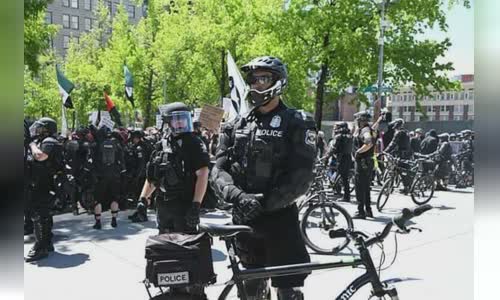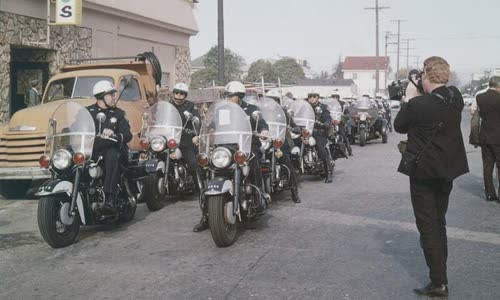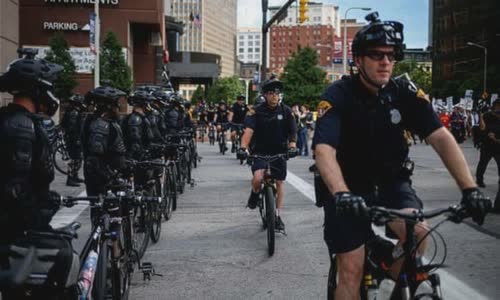The riot bicycle police force in Seattle is the new force that helps the city deal with 200-300 protests every year.
On a Saturday afternoon in early June 2017, under a clear blue sky, small protests against the practice of Sharia Islamic law began to spread from the grounds of City Hall in Seattle, Washington state.

Riot police use bicycle in central Seattle during a protest against Sharia Islamic law in June 2017 Photo: Guardian.
Attendees began to face a much larger anti-fascist protest group.
When leaving the ground, the two sides clashed directly on the corner of 4th street and Cherry.
Immediately, 10 muscular police officers riding black terrain bikes were watching the crowd from across the intersection, jumping into action.
They separated the crowd.
Team action smoothly and effectively by being practiced a lot.
It is also a remarkable product of fundamental change in the tactics of crowd control during the consecutive days of Occupy movements (opposing social, economic and democratic inequalities), Black Lives.
When we think of riot police, we often think of elite forces spilling out of armored vehicles, carrying weapons to deal with the crowd.
But protests in the US take place in a changing digital age.
To that end, riot police have come up with a surprisingly low-tech solution: using bicycles.
Bicycle police are present throughout the events, from the Republican National Convention in Clevaland, Ohio in 2016, when Trump became the party's presidential candidate and attracted many protesters to protest, to
This "iron horse rider" force also became controversial, as some observers called them evidence of the policy of militarizing the police, bringing anti-insurgency techniques to the crowd management.
"The new tool gives them a tactical advantage," said Kristian Williams, a critic of US police policy.

Motorcycle police in Berkeley, California, preparing to face a protest against the war in 1965 Photo: AP.
Back in Seattle in 1999, the officer Dyment was the first to use the bicycle to manage the crowd, when 50,000 people gathered to protest against a World Trade Organization conference.
"They coordinate well and control very well," Dyment said.
Although this is the first riot police to use bicycles, but the police use bicycles have long in the history of the United States.
After the years 1920-1930, bicycles were gradually replaced by motorbikes and cars.
"The concept is to bring the police out of the car to get closer to the people. It's an attempt to tackle the new type of professional racism and assault, to show that police can talk to people.
Vitale called the use of bicycles increasing the police's tactical advantage of trying to win public sympathy, the "tactical dance between protesters and police" that took place throughout American history.
However, the era when the community police using bicycles "did not happen", Virale said.
Bicycles have a clear advantage, helping the police quickly deploy forces to any location.
Bicycles can also be turned into highly effective, inexpensive tools, to control the crowd, allowing a small number of police to form a relatively long fence.
"They form a natural barrier," Dyment said.
Dyment also believes that dealing with crowds by bicycle police is a form of "reduced escalation. Because in every protest group there is a cyclist. That means the police with them have something in common to talk to."
Vitale agrees that the bike allows "flexible operation in a softer way, looks more friendly to the press or observers", but says that "does not help to reduce escalation".

Police use bicycles to set up barriers around protesters ahead of the 2016 Republican conference in Cleveland Photo: Reuters.
Bicycle police may not be charged with batons, but they themselves are equipped with pepper spray.
"Bicycles are essentially a harmless way to hide a potential weapon," Williams said.
Although bicycles had certain disadvantages such as being pushed back more easily than officers riding motorbikes, Williams said that bicycles "obscured the fact that police arrived at the scene, fully equipped with helmets, body armor.
The Seattle bicycle police uniform is reminiscent of the Robocop film, except for T-shirts and shorts, officers wearing Bell Super 3R helmets and wearing bulletproof vests.
Mountain bicycles are the best option "because they are very durable," Dyment said.
A riot police bus with full mechanical parts will repair the broken car spot.
"Can fix most damage to a bicycle in half an hour," Dyment said.
Enduro tire frame manufactured, DT Swiss rim, 25 mm wide frame.
"We often cycle through broken glass," Dyment explained.
Vehicles using 3x9 gear sets but will soon switch to 1x11 to cut maintenance costs.
Each officer himself is a bicyclist, emphasizing the fact that cycling is really the common point between them and the people.
Dyment said that the relationship between the police and the community of protesters in Seattle is not always stressful.
"We know each other well. They yell at us when we protest but normally see each other on the street, we nod and say hello again," Dyment said.



 Janet Ruckemesser
Janet Ruckemesser







